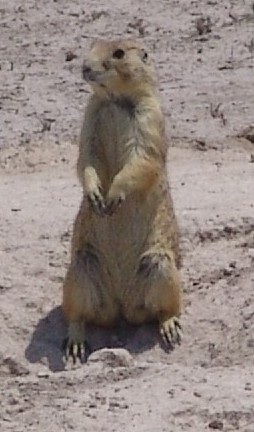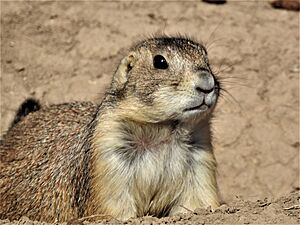Mexican prairie dog facts for kids
Quick facts for kids Mexican prairie dog |
|
|---|---|
 |
|
| Galeana, Nuevo Leon, Mexico | |
| Conservation status | |
| Scientific classification | |
| Genus: |
Cynomys
|
| Species: |
mexicanus
|
The Mexican prairie dog (Cynomys mexicanus) is a type of rodent that is active during the day. It lives in burrows underground in north-central Mexico. Sadly, people sometimes saw them as a problem for farms. This is why they are now an endangered species.
Mexican prairie dogs are related to squirrels, chipmunks, and marmots. They first appeared about 230,000 years ago. They came from a group of the more common Cynomys ludovicianus prairie dogs.
Contents
Life in the Wild
These prairie dogs like to live in flat areas without many rocks. They prefer places that are high up, between 1,600 and 2,200 meters (about 5,250 to 7,200 feet) above sea level. You can find them in parts of southern Coahuila and northern San Luis Potosí in northern Mexico.
They mostly eat herbs and grasses that grow in their plains habitat. They get all the water they need from these plants. Even though they are mainly plant-eaters, they sometimes eat insects too.
Many animals hunt prairie dogs. Their predators include coyotes, bobcats, eagles, hawks, badgers, snakes, and weasels.
Reproduction and Growth
Mexican prairie dogs do not hibernate like some other prairie dogs. Their mating season is usually from January to April. After about one month of being pregnant, females give birth to one litter of pups each year. A litter usually has about four hairless babies.
When they are born, their eyes are closed. They use their tails to help them move around until they can see, which is about 40 days after birth. The young pups stop drinking their mother's milk in late May or early June. This is when some older pups might leave their burrow. By the fall, all the young prairie dogs leave their mothers.
As they get older, young prairie dogs play fight. They bite, hiss, and tackle each other. They can have their own babies after one year. Mexican prairie dogs usually live for 3 to 5 years. Adult prairie dogs weigh about 1 kilogram (2.2 pounds) and are about 35 to 43 centimeters (14 to 17 inches) long. Males are usually bigger than females. Their fur is yellowish, with darker ears and a lighter belly.
Communication and Defense
Prairie dogs have a very complex way of talking to each other. They use high-pitched yips and barks. This is one of the most advanced animal languages. When they sense danger, their defense is to make a loud alarm call and then run away very fast. They can run up to 56 kilometers per hour (35 miles per hour)!
Their Homes: Prairie Dog Towns
Mexican prairie dogs live in large underground homes called "towns." They dig these towns for shelter and protection from predators. A typical town has an entrance that looks like a funnel. This entrance slopes down into a long tunnel, which can be up to 30 meters (100 feet) long. The tunnel has side rooms for storing food and for nesting.
Scientists have found that some rooms in these burrows have special uses. For example, some are nurseries for new mothers and their babies. Prairie dogs have strong muscles in their arms. This helps them dig through the often hard dirt where they live. They can even use their teeth to dig, but this is less common.
A town can have hundreds of animals, but usually there are fewer than 50. There is usually one main male, called an alpha male. Sometimes, other animals like spotted ground squirrels or burrowing owls might share the burrow with the prairie dogs.
Population and Conservation
In 1956, Mexican prairie dogs were found in Coahuila, Nuevo León, and San Luis Potosí. By the 1980s, they had disappeared from Nuevo León. By 1992, their total living area was only about 600 square kilometers (230 square miles).
People sometimes saw them as a problem for agriculture (farming) and raising cattle. This is because their burrows could damage fields, and they sometimes ate crops. Because of this, they were often poisoned. This led to them becoming endangered in 1994.
Today, Mexican prairie dogs live in less than 4% of the area they used to live in. Their living space shrank by 33% between 1996 and 1999.
The main area where Mexican prairie dogs live now is called El Tokio. These are grasslands where the states of San Luis Potosí, Nuevo León, and Coahuila meet. It's hard to count exactly how many prairie dogs there are because they live underground. But using satellite imagery has helped scientists map the areas where they live.
Groups like Pronatura Noreste and Profauna are working to protect prairie dogs and other animals that live near them, like shorebirds and birds of prey. As of 2007, Pronatura Noreste has made agreements with local communities and landowners. These agreements help protect over 42,000 acres (170 square kilometers) of Mexican prairie dog grasslands.




